Biodiversity of Irian Jaya
Flora
Fauna
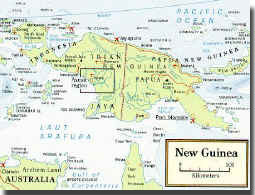 New
Guinea is the second largest island on our earth after Greenland and
posses probably the most biggest and originally wilderness. These
Island posses a total area of 771,900 square kilometers. Along 141 Degree
of Longitude New Guinea get divided in 1828. The western part
occupied by the Dutch troops who established the Nederland Nieuw Guinea
colonial government in Manokwari on 1878, and the eastern part divided
into the German (northeastern part) and British (southeastern part)
colonies. After the German loss in World War I (1914-1918), the
eastern part united by the Nation League and administered under the
Commonwealth Australia mandate. Later, this colony became
independent as the State of Papua New Guinea in 1975. The western
part annexed by Indonesian first President Soekarno in 1962 and then,
integrated as the West Irian Province in 1963 following one year-UNTEA
(United Nation Temporary Administrative Administration)
administration. Later, Second President of Indonesia, Soeharto give
the name of Irian Jaya. These name have been changed by reformist
Indonesian Fourth President Abdurrahman Wahid (Gus Dur) into Papua
on 1 January 2000. The whole island has more than 600 islands
all around. Geographically, the New Guinea belongs to the Pacific
region and constitute to Melanesia nations.
New
Guinea is the second largest island on our earth after Greenland and
posses probably the most biggest and originally wilderness. These
Island posses a total area of 771,900 square kilometers. Along 141 Degree
of Longitude New Guinea get divided in 1828. The western part
occupied by the Dutch troops who established the Nederland Nieuw Guinea
colonial government in Manokwari on 1878, and the eastern part divided
into the German (northeastern part) and British (southeastern part)
colonies. After the German loss in World War I (1914-1918), the
eastern part united by the Nation League and administered under the
Commonwealth Australia mandate. Later, this colony became
independent as the State of Papua New Guinea in 1975. The western
part annexed by Indonesian first President Soekarno in 1962 and then,
integrated as the West Irian Province in 1963 following one year-UNTEA
(United Nation Temporary Administrative Administration)
administration. Later, Second President of Indonesia, Soeharto give
the name of Irian Jaya. These name have been changed by reformist
Indonesian Fourth President Abdurrahman Wahid (Gus Dur) into Papua
on 1 January 2000. The whole island has more than 600 islands
all around. Geographically, the New Guinea belongs to the Pacific
region and constitute to Melanesia nations.
The Landscape
 The
island shaped by the large mountains which the island is pull through. Large
valleys and steep rising mountains are the typical picturesque at the Central
Mountain Range. The highest peak are in the western part of
the island. It is the Puncak Jaya with its 4,884 m peak. These are the
highest mountain range between the Himalaya and the Andes. On the eastern part
of New Guinea, there is 4,509 m high Mt. Wilhelm. In the south of Papua
(Irian Jaya) we can found the wide swamp areas of Asmat. To the north
there are also many wide swamp areas. Especially we have to name the
Mamberamo River area. These will be the most biggest swamp area of this kind. In
Papua New Guinea you can find some untypical landscapes for New Guinea.
Especially in the southern part, where there is a grassland savanna as well
as in the southeastern tip of Papua (Irian Jaya), near Merauke. To
the north the landscape will be shaped by the big rivers of Fly and Digul.
Also a hill landscape have to be pronounced. (See map)
[back
to top]
The
island shaped by the large mountains which the island is pull through. Large
valleys and steep rising mountains are the typical picturesque at the Central
Mountain Range. The highest peak are in the western part of
the island. It is the Puncak Jaya with its 4,884 m peak. These are the
highest mountain range between the Himalaya and the Andes. On the eastern part
of New Guinea, there is 4,509 m high Mt. Wilhelm. In the south of Papua
(Irian Jaya) we can found the wide swamp areas of Asmat. To the north
there are also many wide swamp areas. Especially we have to name the
Mamberamo River area. These will be the most biggest swamp area of this kind. In
Papua New Guinea you can find some untypical landscapes for New Guinea.
Especially in the southern part, where there is a grassland savanna as well
as in the southeastern tip of Papua (Irian Jaya), near Merauke. To
the north the landscape will be shaped by the big rivers of Fly and Digul.
Also a hill landscape have to be pronounced. (See map)
[back
to top]
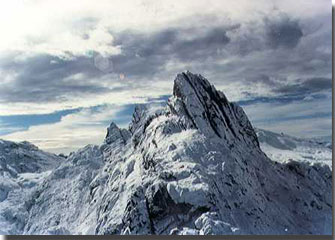 The
backbone of New Guinea is the above 4,000 m central cordillera. Snows and
ices covers the highest peak, Puncak Jaya Peak, the highest peak in
Australasia/Oceania. Ice rats can be found at the 4,250 m altitude as well
as long nose Echidna in 4,150 m altitude.
The
backbone of New Guinea is the above 4,000 m central cordillera. Snows and
ices covers the highest peak, Puncak Jaya Peak, the highest peak in
Australasia/Oceania. Ice rats can be found at the 4,250 m altitude as well
as long nose Echidna in 4,150 m altitude.
The Montane Rainforest areas of the island offer a rich variety of views, thick low shrubs, and stringy trees clinging grimly to the sides of steep mountain slopes. Wildlife is more plentiful here, with birds prevalent in all shapes and sizes. Tiny finches are found here, as well as rare swiftlets and Birds of Paradise. Occasional raptors can be seen.
Mammals abound in the montane forests, home of the ringtails, tree kangaroos, cuscus, dasyurids, quolls and many species of rats. Bats are also extremely common, and several species can be seen flying around the lights of Tembagapura, Hidden Valley, Ridge Camp and the Mill feeding on moths and other nocturnal insects.
It is thought by scientists that many species of animals and birds remain to be discovered, but the sheer density of the jungle (itself containing many unknown plant species) makes faunal surveys difficult in the extreme. Freeport sponsors many such surveys, and new discoveries are continually. [back to top]
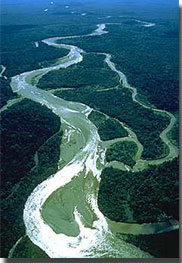 Lowland
is a very wide flat plain consists of tropical rainforest separated by rivers
and creeks. Rivers usually uses for transporting people and stuffs from
one place to another. Most of the rivers have quite calm flow since it has
quite flat bed. Fish is one of major diet for local people. Some
high value fish are Barramundi and Goldfish as well as Arwana fish, that lives
mostly in the lowland river valley and estuaries.
Lowland
is a very wide flat plain consists of tropical rainforest separated by rivers
and creeks. Rivers usually uses for transporting people and stuffs from
one place to another. Most of the rivers have quite calm flow since it has
quite flat bed. Fish is one of major diet for local people. Some
high value fish are Barramundi and Goldfish as well as Arwana fish, that lives
mostly in the lowland river valley and estuaries.
Waterfowl, heron, eagle and hornbill are inhabit the lowland forests as well as parrots, cockatoo and extraordinary bird of paradise. Tree kangaroo and wallabies), foxes, bats, possums, cuscus, and rats are inhabit the lowland pristine tropical rainforest, while wallabies are abundant in savanna. [back to top]
Geological origin
Approx. 30 million years ago, the mountains arise at the island. Still, until today the different tectonic discs in this region are in motion. This reflects itself in the many earthquakes in this region. About 50,000 - 30,000 BC, New Guinea and Australia a land mass formed. This is changed depend on the raising sea level after the last ice age, around 10,000 BC. The first provable settlements date themselves on approx. 24,000 BC. [back to top]
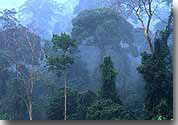 New
Guinea is covered by a green lush carpet of tropical forests which
still keeps many secrets to itself. For
decades it was protected and virtually nestled away by Indonesia and could
maintains its basic original features. The island consists of many different
ecosystem, ranging from north coasts to 4,884 m high snow peak in Central
Mountain Range and the southern mangrove swamp. At the center of the
island, the Central Mountain Range keeps a 400 sq. m snow and ice region,
the only ice peak in the equator zone. The peak located only 2 degrees
south of the equator.
New
Guinea is covered by a green lush carpet of tropical forests which
still keeps many secrets to itself. For
decades it was protected and virtually nestled away by Indonesia and could
maintains its basic original features. The island consists of many different
ecosystem, ranging from north coasts to 4,884 m high snow peak in Central
Mountain Range and the southern mangrove swamp. At the center of the
island, the Central Mountain Range keeps a 400 sq. m snow and ice region,
the only ice peak in the equator zone. The peak located only 2 degrees
south of the equator.
The flora and fauna of New Guinea rank with its tropical rainforest among the species-richest on earth. Hardly another country posses such resources at still unknown primary types like the island. However, 180 mammals, 700 birds, 6,000-7,000 fishes, as well as several thousand types of insect is so far well-known, and that might be according to estimations only half of all occurring kinds. Approx. 12,000 listed flowering plants, as well as over 20,000 tree species with approx. 80 epiphytes round the picture up. The nature can get here the most special colors and forms. [back to top]
Flora
Within the abundant assortment of habitats and landscapes spread over an altitudinal range of nearly 5,000 meters, Irian Jaya contains the riches concentration of plant life in all of Indonesia. With the exception of the monsoon rain shadow in the southeast, the province's luxuriant forests lie entirely within the tropical rainforest belt and contain a floristic diversity of tremendous proportions. A conservative estimates of floral diversity of all Papuasia - including all the families - is thought to number well over 20,000 species (Womersley, 1978). Mainland New Guinea by far holds the largest store of this diversity with an estimated 16,000 species (Hope, 1982, pers. comm.). A total of 1465 angiosperm genera has been recorded for the island, with an estimated 9,000 species represented (Paijmans, 1976); as taxonomic studies continue we can certainly expect that this number will exceed 10,000 in future years. At least 124 genera of flowering plants are endemic, compared with 59 endemic on Borneo, 17 on Sumatra and 10 on Java (FAO, 1981). Although most of the plants represent well-known family and generic groups, species endemicity in New Guinea is exceptionally high at about 90% (Hope, 1982, pers. comm.).
New Guinea's flora is included in the eastern subdivision of Indo-Malayan Floral Region, the richest in the world in plants useful to man (van Balgooy, 1976; Leach and Osborne, 1985). The lowlands, which contain the widest expanses of tropical rainforest to be found in Southeast Asia, are dominated by taxa of the Indo-Malayan area. However, unlike forests elsewhere in Malaya, members of Dipterocarpacea are rare with only three genera (eight species) compared with nine genera and 262 species in Borneo (FAO, 1981; MacKinnon and MacKinnon, 1968). Dipterocarp elements such as oak (Quercus junghunii), red cedar (Toona sereni) and vatica (Vatica papuana) are most frequently encountered between the elevations of 600-1400 m (Richardson, 1968). The montane flora, however, is dominated by distinct southern elements of Australasia, sometimes termed sub-antarctic, which include the expansive forests of Antarctic beech (Nothofagus). Conifers are represented by the southern gymnosperms, including the podocarps (Podocarpus), kauri pine (Agathis) and the hoop and klinki pines (Araucaria), all valuable timber species.
Irian Jaya's great floral diversity and rarity of dipterocarps are generally disadvantageous to timber exploitation. Its most valuable species are the cabinet timbers, New Guinea walnut (Dracontomelum mangiferum) and black ebony (Diospyros), along with conifers and pencil cedars (Palaqium). The popular export construction timbers are ironwood (Intsia bijuga and I. palembanica), taun (Pometia pinnata and P. tomentosa) and a variety of others, which include Octomelus, Canarium, Calophyllum and Mastiziodendron. Other important tree species include sago, which is widespread and extremely important palm of swampy area. It is the basic staple of all lowland peoples, who process its starchy pith which is then prepared in a variety of ways. Its leaves are used in house construction. Sago palms are also of great significance to many of the lowland cultures, which is well exemplified in the art and legends among the Asmat people of the south coast (Gerbrands, 1967; Mitton, 1983). The casuarinas (Casuarina equisetifolia, C. papuana, C. nodiflora) are employed both to increase soil fertility and as wood crops in shelter belts between gardens in some highland areas under rotational agriculture. The high stilt-rooted Pandanus is a widespread genus very common in all types of forests up to 3050 m, with some species producing edible fruits. Pandan leaves are variously dried and used as building materials or cigarette papers, or stitched together as rain-capes and sleeping mats. There are ethno-botanical lists composed of hundreds of plants which are used by the indigenous people for a wide variety of purposes, including medicinal, stimulants and narcotics, ritual and magic, tools and weapons, building of houses and canoes, making cloth, ceremonial dress and simply decoration (Powell, 1976). It is quite clear that some of these little-known species also hold a wealth of uses for modern man. [back to top]
 Orchids
are the major and most fascinating group of colorful plants in New
Guinea. More than 2770 species have been documented for 134 genera,
dominated by Dendrobium and Bulbophyllum (Millar,
1978). This group alone represents nearly one-third of all the
species of flowering plants on the island. They have a wide
altitudinal range, with some ground orchids occurring above 3750 m in the
central cordillera, but their greatest variety occurs in the lowland
rainforest. Rhododendrons are among the prettiest flowering
species on the island. There are more than 250 different species
(MacKay, 1976), most of which range from mid-montane forest up to about
4000 m, and nearly all are endemic.
Orchids
are the major and most fascinating group of colorful plants in New
Guinea. More than 2770 species have been documented for 134 genera,
dominated by Dendrobium and Bulbophyllum (Millar,
1978). This group alone represents nearly one-third of all the
species of flowering plants on the island. They have a wide
altitudinal range, with some ground orchids occurring above 3750 m in the
central cordillera, but their greatest variety occurs in the lowland
rainforest. Rhododendrons are among the prettiest flowering
species on the island. There are more than 250 different species
(MacKay, 1976), most of which range from mid-montane forest up to about
4000 m, and nearly all are endemic.
A variety of colorful legumes decorates the high canopy of the lowland rainforest, the most famous of which is the bright red flame of Irian (Mucuna novaeguineensis). Many species of flowering gingers brighten the forest in an array of pink and oranges, while at the highest elevations, the sub-alpine and alpine meadows are dressed in the colors of Epilobium, Gentiana, Geranium, Ranunculus, and Potentilia, which are among the abundant herbs. Interesting tree species such as Eugenia and Ficus of the rainforest sprout their buds, flowers and fruits directly from the bark of the tree trunk, an amazement to newcomers to the forest.
Among the strangest and most unusual plant forms in the province are the epiphytic giant ant-house plants (Muymecodia brasii) which reach up to two meters in length in the sub-alpine forest of the Kemabu Plateau. Their bulbous bases are honeycombed with galleries inhabited by hundreds, sometimes thousands of ants. Pitcher plants (Nepenthes) are common on nitrogen poor soils. The lip of the pitcher is coated with a sweet fluid substance which attracts ants, who fall into an enzyme bath to be digested and absorbed into the plant's tissue.
The glowing fungi (Mycena) growing up from the forest floor emit an iridescent light from their gills in the darkest part of the night, but both the physiology of this performance and it s purpose are unknown. The fruiting body of the Amorphophallus campanulatus stands nearly half-a-meter high from its ground perch in the savannahs of the southeast. It gives off the not-to-be forgotten smell of rotting meat or something worse which attracts pollinating insects.
From the useful to the important and the unusual, the flora of this province holds the riches and most diverse storehouse of genetic resources in the entire Indonesian archipelago. It represents one of the greatest challenges to scientists, to unravel the complexities that it contains, and a great responsibility of the government to protect this natural wealth so that it can be studied and understood for the benefit of humankind. [back to top]
Fauna
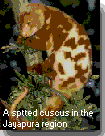 The
land mammals of New Guinea include more than 200 species, which are both
elements of the native pre-Pleistocene fauna and introduced forms
(Ziegler, 1982). Thus far, 174 mammals species which form the wild
population are known to occur in Irian Jaya and fall into the following
orders: Monotremata (2), Marsupialia (57), Chiroptera (63), Carnivora (1),
Artiodactyla (2) and Rodentia (49) (Petocz and deFretes,
1983).
The
land mammals of New Guinea include more than 200 species, which are both
elements of the native pre-Pleistocene fauna and introduced forms
(Ziegler, 1982). Thus far, 174 mammals species which form the wild
population are known to occur in Irian Jaya and fall into the following
orders: Monotremata (2), Marsupialia (57), Chiroptera (63), Carnivora (1),
Artiodactyla (2) and Rodentia (49) (Petocz and deFretes,
1983).
For the most part, the first two orders are affiliated to the Australian Zoogeographic Region, while the others are related more to the Oriental Region, or have otherwise been introduced by man (only 10 species). This strange mixture of land mammals is a perfect illustration of New Guinea as the crossroads of life between these two great zoogeographic regions and clearly reflect its past geological history and land connections, climatic changes and faunal migrations.
Of all the species in the province, there are 100 endemic forms with 47 among the monotremes and marsupials, and 53 among the bats and rodents. The mammalian diversification bears witness to the massive habitat expansion due to mountain building and climatic fluctuations and the periods of restricted genetic flow that occurred prior to and during the Ice Ages of the Quaternary Period. Some of the interesting forms include the two primitive monotremes, the Short-beaked Echidna (Tachyglossus aculeatus) of the lowlands and hills, and the Long-beaked Echidna (Zaglossus bruijni) of the high mountains, the strange endemic genera of marsupial mice (Dasyuridae) and the bandicoots (Peramelidae). Eight species of cuscus (Phalanger and Spilocuscus) occur in the province (Flannery et. al. 1987; George, 1987; Groves, 1987), as well as pygmy possums (Cercatetus caudatus and Distochurus pennatus) and ringtails (Pseudocheirus).
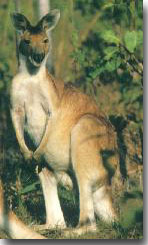 There
are four species of tree kangaroo (Dendrolagus), as well as forest
wallabies (Dorcopsis) and the common Agile Wallaby (Macropus agilis)
of the southeastern plains and woodlands. The chiroptera are an
incredibly diverse group, with tube-nose bats, flying foxes, sheath-tailed
bats, horseshoe bats and mastiff bats, to mention but a few. Among
the equally diverse, rodent are true giant rats such as Hyomys goliath
and Mallomys rothschildi, the tiny shrew mouse (Neohydromys
fuscus) and several species of tree mice (Pogonomys).
There
are four species of tree kangaroo (Dendrolagus), as well as forest
wallabies (Dorcopsis) and the common Agile Wallaby (Macropus agilis)
of the southeastern plains and woodlands. The chiroptera are an
incredibly diverse group, with tube-nose bats, flying foxes, sheath-tailed
bats, horseshoe bats and mastiff bats, to mention but a few. Among
the equally diverse, rodent are true giant rats such as Hyomys goliath
and Mallomys rothschildi, the tiny shrew mouse (Neohydromys
fuscus) and several species of tree mice (Pogonomys).
The introduced Rusa Deer (Cervus timorensis) now occurs in the three major lowland district to the north, south and west of the central cordillera and is the largest wild land mammals on the island. Large carnivorous predators are absent in New Guinea. Another introduced species found in Irian Jaya, including Long-tailed Macaque (Macaca fascicularis) in Jayapura's Vim forest, feral pigs (Sus scrofa) and feral dogs (Canis familiaris). [back to top]
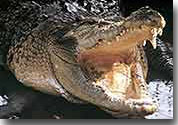 The interesting herpetofauna boasts a great diversity of
species, but is still incompletely known. Many new species are still
being identified from material housed in museums, without further field
work. According to the most recent information and estimates, a
breakdown of faunal numbers include There are
253 reptiles, including 89
snakes, 150 lizards, two crocodiles, six sea turtles and six
freshwater
tortoises; it is expected that more than 100 snakes and 200 lizards actually
occurs on the island (Scott, Parker and Menzies, 1977; Allison, 1982; McDowell, 1974, 1975,
1979). Among the reptiles the known are the Estuarine crocodile
(Crocodylus
porosus) and the endemic New Guinea Crocodile
(C. novaguinea), species which have been exploited for their valuable
skins since the turn of the century. The monitor (Varanus)
are other active predators and the seven species that occur on the island
range in length from less than a meter to more than three meters
long. Adult crocodiles and monitors probably have no enemies or
predators other than man.
The interesting herpetofauna boasts a great diversity of
species, but is still incompletely known. Many new species are still
being identified from material housed in museums, without further field
work. According to the most recent information and estimates, a
breakdown of faunal numbers include There are
253 reptiles, including 89
snakes, 150 lizards, two crocodiles, six sea turtles and six
freshwater
tortoises; it is expected that more than 100 snakes and 200 lizards actually
occurs on the island (Scott, Parker and Menzies, 1977; Allison, 1982; McDowell, 1974, 1975,
1979). Among the reptiles the known are the Estuarine crocodile
(Crocodylus
porosus) and the endemic New Guinea Crocodile
(C. novaguinea), species which have been exploited for their valuable
skins since the turn of the century. The monitor (Varanus)
are other active predators and the seven species that occur on the island
range in length from less than a meter to more than three meters
long. Adult crocodiles and monitors probably have no enemies or
predators other than man.
Among the most common lizards are the
numerous skinks and nocturnal geckos. Ther are other peculiar forms
such as the legless lizard (Dibamus novaguineae) and the arboreal
dragon lizards of the Genus Gonocephalus. Snakes are also
well-represented and range from the generally dark poisonous varieties of
the lowlands, including the Death Adder (Acanthopsis antarticus)
and Taipan (Oxyuranus scutellatus), the colorful but highly
venomous sea snakes, to New Guinea's most striking serpent, the
non-venomous Green Tree Phyton (Chodrophyton
viridis). Some interesting pythons are Morelia boeleni,
M. amethystina, M.
spilota, Liasis fuscus and Leiphyton albertisii.
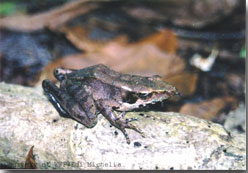 The humid and moist environment of
the vast rainforests of New Guinea supports more frogs than most areas of
the world. Some species are found as high as 3,850 m but the
greatest number occurs in the lowlands. Frogs are familiar members
of New Guinea's nighttime orchestra and range in a continuum of sizes and
colors. The most numerous are the tree frogs, numbering about 120
species, with specially adapted suction-cup-like fingers on their
forelimbs. However, there are also many burrowing, aquatic and
surface dwellers. The large native anuran is the White-lipped Tree
Frog (Litoria infrafrenata), which may reach length of up to 135
mm. All species are carnivorous and most are nocturnal. [back
to top]
The humid and moist environment of
the vast rainforests of New Guinea supports more frogs than most areas of
the world. Some species are found as high as 3,850 m but the
greatest number occurs in the lowlands. Frogs are familiar members
of New Guinea's nighttime orchestra and range in a continuum of sizes and
colors. The most numerous are the tree frogs, numbering about 120
species, with specially adapted suction-cup-like fingers on their
forelimbs. However, there are also many burrowing, aquatic and
surface dwellers. The large native anuran is the White-lipped Tree
Frog (Litoria infrafrenata), which may reach length of up to 135
mm. All species are carnivorous and most are nocturnal. [back
to top]
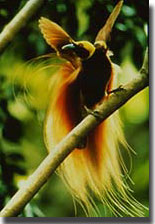 Bird
of the New Guinea is extremely rich, highly diverse and unique in many aspects,
with some 725 species, known or expected to occur with the region (Beehler et.
al., 1986). The region contains a substantial proportion of these, with
712 species recorded, including 582 breeding land birds, 40 seabirds, 56
Palaearctic migrants and 34 Australian migrants (Beehler and Finch, 1985;
Diamond, 1986). Of these, 643 species have thus far been recorded from
Irian Jaya, including 269 endemics (Petocz et. al, 1983; Diamond, 1981-1983,
pers. comm.; Diamond, 1986).
Bird
of the New Guinea is extremely rich, highly diverse and unique in many aspects,
with some 725 species, known or expected to occur with the region (Beehler et.
al., 1986). The region contains a substantial proportion of these, with
712 species recorded, including 582 breeding land birds, 40 seabirds, 56
Palaearctic migrants and 34 Australian migrants (Beehler and Finch, 1985;
Diamond, 1986). Of these, 643 species have thus far been recorded from
Irian Jaya, including 269 endemics (Petocz et. al, 1983; Diamond, 1981-1983,
pers. comm.; Diamond, 1986).
 The avifauna is largely Australian, but
certain elements such as the Blyth Hornbill (Rhyticeros plicatus),
tree swifts (Hemiprocnidae), shrikes (Laniidae) and sandpipers (Scolopacidae)
are not only of an Oriental origin but also do not extend into Australia
(Pratt, 1982). Probably more than any other group, birds have
attracted the attention of all visitors and voyagers to New Guinea, and
they are also well-known and utilized by many of the indigenous
inhabitants. Knowledge of the distribution and endemism among the
avifauna has been important guideline in formulating the reserve design
for Irian Jaya (see Diamond, 1982; 1986; Petocz, 1983; 1985). The
most famous, of course, are the Bird of Paradise (Paradisaeidae), of which
there are 26 species in the province. The most colorful (and
illegally sought after) are those with long and delicate breast plumes, of
the genus Paradisaea which include the Greater Bird of Paradise (Paradisaea
apoda), the Lesser Bird of Paradise (P. minor), and the Red
Bird of Paradise (P. rubra) of Waigeo and Batanta Islands.
The long-tailed Astraphia spp., the Twelve-wired Bird of Paradise (Seleucidis
melanoleuca), the sicklebills (Epimachus), Riflebird (Plitoris
magnificus) and parrotias (Parotia) are also a highly
ornamented birds. The ostentatious display feathers among the males
are an example of evolution gone wild in the absence of predators.
The island takes its name - Palau Cassowary - from the curious flightless
Cassowary (Casuarius), the largest naturally occurring animals in
New Guinea, which shares its fame with the world's largest pigeons (Goura
spp.). Nine species of the incredible bowerbirds (Ptilonorhynchidae)
occur in Irian Jaya, and it was only in 1981 that the lost bird of New
Guinea, the Golden-fronted Bowerbird (Amblyornis flavifrons), was
rediscovered in Irian Jaya after remaining a mystery for nearly seven
decades since the first skins were brought to Europe (Diamond, 1982).
The avifauna is largely Australian, but
certain elements such as the Blyth Hornbill (Rhyticeros plicatus),
tree swifts (Hemiprocnidae), shrikes (Laniidae) and sandpipers (Scolopacidae)
are not only of an Oriental origin but also do not extend into Australia
(Pratt, 1982). Probably more than any other group, birds have
attracted the attention of all visitors and voyagers to New Guinea, and
they are also well-known and utilized by many of the indigenous
inhabitants. Knowledge of the distribution and endemism among the
avifauna has been important guideline in formulating the reserve design
for Irian Jaya (see Diamond, 1982; 1986; Petocz, 1983; 1985). The
most famous, of course, are the Bird of Paradise (Paradisaeidae), of which
there are 26 species in the province. The most colorful (and
illegally sought after) are those with long and delicate breast plumes, of
the genus Paradisaea which include the Greater Bird of Paradise (Paradisaea
apoda), the Lesser Bird of Paradise (P. minor), and the Red
Bird of Paradise (P. rubra) of Waigeo and Batanta Islands.
The long-tailed Astraphia spp., the Twelve-wired Bird of Paradise (Seleucidis
melanoleuca), the sicklebills (Epimachus), Riflebird (Plitoris
magnificus) and parrotias (Parotia) are also a highly
ornamented birds. The ostentatious display feathers among the males
are an example of evolution gone wild in the absence of predators.
The island takes its name - Palau Cassowary - from the curious flightless
Cassowary (Casuarius), the largest naturally occurring animals in
New Guinea, which shares its fame with the world's largest pigeons (Goura
spp.). Nine species of the incredible bowerbirds (Ptilonorhynchidae)
occur in Irian Jaya, and it was only in 1981 that the lost bird of New
Guinea, the Golden-fronted Bowerbird (Amblyornis flavifrons), was
rediscovered in Irian Jaya after remaining a mystery for nearly seven
decades since the first skins were brought to Europe (Diamond, 1982).
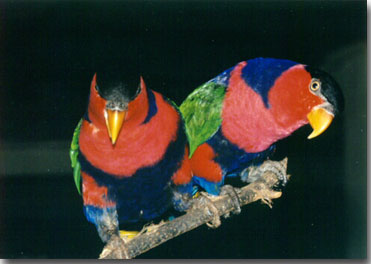 Among 85 Indonesian parrots (Psittacidae), 44 species found in New Guinea including 28 endemic
species, ranging from the rarely seen Vulturine or Pesquest's Parrot (Psittrichas
fulgidus) to the hordes of flocking species such as Rainbow Lorikeet (Trichloglossus
haemotodus) and the many species of smaller fig and pygmy parrots. Of
those species, only 5 are protected.
Among 85 Indonesian parrots (Psittacidae), 44 species found in New Guinea including 28 endemic
species, ranging from the rarely seen Vulturine or Pesquest's Parrot (Psittrichas
fulgidus) to the hordes of flocking species such as Rainbow Lorikeet (Trichloglossus
haemotodus) and the many species of smaller fig and pygmy parrots. Of
those species, only 5 are protected.
Kingfishers (Alcedinidae) are also well presented with a greater variety of form and habit than anywhere else in the world. The honeyeaters (Meliphagidae) are the largest group with 59 species thus far documented in Irian Jaya. Avian predators with the widest ranges of all, such as the New Guinea Harpy Eagle (Harpyopsis novaguinea) and Wedge-tailed Eagle (Aquila audax), soar over the mountains and lowlands in search of prey, while some of the more bizarre forms such as the nocturnal Papuan Frogmouth (Podargus papuensis), mound-building megapods (Megapodiidae) and the strange Greater Melampitta (Melampitta gigantea), which nests and roosts underground in deep limestone sinkholes, emphasize the tremendous avian diversity in the region. The list is as interesting as it is endless (Petocz et. al. 1983. [back to top]
There are probably in the order of 80,000-10,000 insect species in New Guinea, but nobody really knows for sure. According to Gressits (1982), the insect fauna is primarily Oriental in origin. More than any other group, speciation has been very prolific among the insects, which contains the greatest diversity on the island.
The colorful butterfly and moth faunas are thought to number over 5000 species and they occur in all habitats throughout the province (d'Abrera, 1975; 1977). Irian Jaya is famous in its large and conspicuous bridwing butterflies, the Ornithopterids, which have their world center of diversity in the Arfak Mountains and Anggi Lake region of the Bird's Head. Noticeable are the spiders, a group with over 800 species, that include large orb weavers (Argiopidae), jumping spiders (Salticidae), camouflaged lichen spiders (Sparrassidae) that blend into the color and bark of trees on which they hunt their prey, and the largest forms such as the giant Bird-eating Spider (Selenocosmia crassides - Theraphosidae) which lays out a system of trip lines from its burrow that alert the animal to prey. By far the largest group is the beetles, which probably number over 30,000 species and range from huge fist-sized forms to species only a millimeter or two in length. Among these are the colorful weevils or snout beetles (Curculionidae), perhaps the largest insect family on the island, thought to number over 5000 species which occupy numerous habitats in the forest. Some forms carry a variety of plant life in their backs, including gardens of algae, fungi, lichens, liverworts and mosses (Ryan, 1972). The curious stick insects (Phasmids), which sometimes attain lengths of 25 cm, are common in the lowlands and can be frequently seen feeding and maneuvering among casuarina trees. There are also delicate and well-camouflaged katydids or leaf insects, a variety of grasshoppers, and unfortunately for humans plenty of mosquitoes and biting ants. This great diversity feeds a tremendous variety of birds and other faunal elements, polinates trees and other plant life, helps to decompose forest litter, while also making some places in the province most inhospitable to people.
The insects offer a tremendous research challenge to scientists, with so many unknowns in their taxonomy alone, and it is likely that the many mysteries yet to unfold will have useful applications to medicines, and behavioral and evolutionary studies. Some groups such as butterflies, moths and beetles have the economic potential that can be beneficial to improve the lot of some of the poorest and most neglected indigenous tribes in the province, by insect farming and marketing techniques, as has already been accomplished in Papua New Guinea. [back to top]
